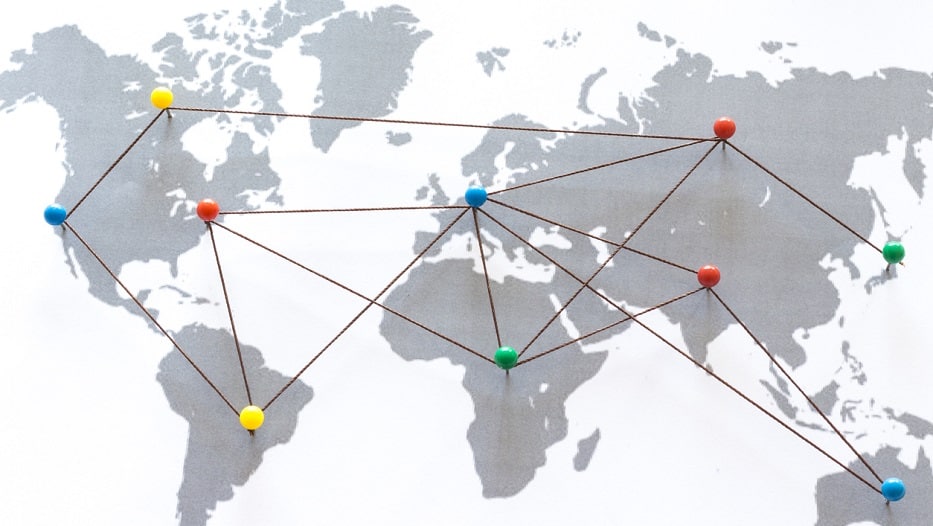Julia Maria Gomez de Avila Segade | 18/04/2023
‘Asia-East Coast of South America’ is the sixth global ocean route by volume of mobilized containers. Connections between the continents have fourteen direct services between the main ports of both regions, although there is still a long way to go.
Since the expedition of Fernando de Magallanes and Juan Sebastián Elcano managed to circumnavigate the globe between 1519 and 1522, there is one theme that obsesses merchants and governments around the globe: optimizing maritime routes to seek maximum efficiency in world trade. For centuries, empires and nations have navigated the globe by turning oceans into true highways for goods. Today, sea transport functions as a gigantic network with established routes or lines, stopovers and transshipments, from which any goods can be shipped from one point to another on Earth.
According to ranking data from the World Shipping Council, the global association that brings together the world’s leading shipping freight operators:
- The ‘Asia-North America’ route is number one in terms of volume transported with 26.57 million TEUs (20-foot containers, usual unit of measure in sea transport) mobilized.
- ‘Asia-Northern Europe’ exchanged 15.06 million TEUs.
- ‘Asia-Mediterranean’, 91 million TEU.
- ‘Asia-Middle East’, at 7.74 million, ranks fourth.
- Fifth would be ‘Northern Europe-North America’, at 5.40 million.
- Sixth is the ‘Asia-East Coast of South America’ route with 2.07 million TEUs.
It is precisely the latter that, due to its enormous potential and development capacity, has raised the interest of the ECLAC (Economic Commission for Latin America and the Caribbean), a UN-dependent body that has prepared a recent report on “Sea Freight Connections between Asia and the Pacific and Latin America”, where it analyzes the main maritime connections of containers and the challenges that must be faced on the routes between both continents.
This is a highly concentrated sector, where the world’s first seven freight vessel operators concentrate 75.7% of market
“Colonial” Business Model
The ECLAC study focuses on bilateral maritime trade relations of the most active countries on both continents over the past five years, with China, Japan, South Korea or Australia (on the Asia Pacific side) and Argentina, Brazil, Colombia and Peru (on the Latin American side). It is noteworthy that, apart from nuances, there are common traits in all of them. The Asian countries, for example, primarily export manufacturing, with particular importance of electronics and technology products. Meanwhile, Latin American exports are mainly concentrated in raw materials and agricultural products.
The current relationship between these regions closely resembles the colonial period between the Americas and Europe, where metropolises imported raw materials that transformed and processed and then resold in the form of higher-value-added manufacturing to the colonies themselves. This generated an unbalanced trade balance in favor of the old continent at the time-and today it generates an unbalanced trade balance in favor of Asian countries which, for the same volume of exported cargo, receive much more income for the type of product sold.
Another of the particularities that mark these relationships is the very nature of global sea transport. This is a highly concentrated sector, where the world’s first seven freight vessel operators concentrate 75.7% of market share and they decide which types of routes connect the main ports on each continent. In addition to this situation, there is also another key element: the narrow chokepoints through which a large number of goods circulate and which become bottlenecks for global trade, such as the Suez Canal, the Malacca Strait or the Panama Canal. With these circumstances and conditions, Asia and Latin America are currently connected by fourteen direct services: four from Asian ports to ports on the East Coast of Latin America (which concentrate the greatest traffic of goods) and ten to the South American West Coast, by the Pacific.
Asia and Latin America are currently connected by fourteen direct services
Challenges and the Path Forward
Taking into account the population of the regions that link these routes – more than 1.5 billion people – we are talking about a very small number of direct services and volume of goods even with respect to their potential. This is mainly due to a poor infrastructure network in Latin America, whose main challenge is to improve port facilities and, above all, logistics infrastructure in the hinterland —the area behind ports— of stops and destinations. Services at the plant of origin, plant-to-port transport, services at the origin port, services at the destination port, transport to the destination plant or services at the destination plant are especially important. Logistics infrastructure includes railroads, rivers, roads, and nodes linking these, such as ports, airports, logistics platforms, and border points.
Unfinished Business in the Americas
Another challenge is to improve bureaucracy and legislation on both sides of these “maritime highways” as they are very restrictive in the case of Asian countries and unreliable on the Latin American side. Waiting times and customs optimization are another key consideration when reducing marketing costs and increasing transaction volume. Thus, the ECLAC study also includes a sample of interviews with traders and logistics operators, who jointly point out, among other things, the paths to follow:
- Digitalization in all sections of the chain, mainly in customs processes.
- The development of waterways for the transport of goods in Latin America, as a cheaper and more sustainable alternative to roads.
- The need to establish direct services with ports in Southeast Asia, which can currently only be reached with a stopover.
Ultimately, the big challenge in increasing the ability to exchange goods on sea routes between Asia Pacific and Latin America lies in improving the commercialization models between stakeholders, creating trust and predictability in transactions and the development of policies by the countries for the planning of long-term infrastructure both in ports and in the hinterland.
Keep reading… Electrical mobility: a sure bet for the energy transition in Mexico





